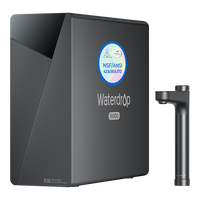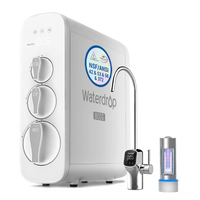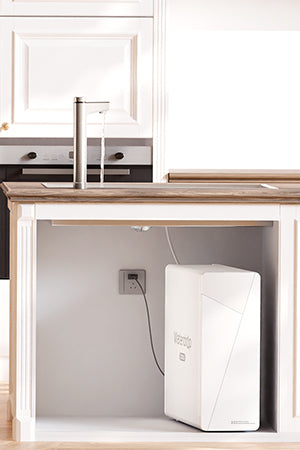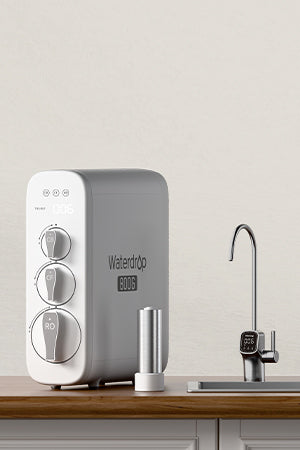People researching water filtration technologies like UV sterilization, ultrafiltration, and reverse osmosis are consistently looking for more information. The earlier mentioned water filtration technologies are the most effective and advanced filtration methods suitable for residential consumers. Nevertheless, which one is the best?
We also introduce high-tech hydrogel as another highly efficient water purification technology apart from the three water filtration methods.
This article distinguishes between the water purification systems, including reverse osmosis, ultraviolet, ultrafiltration, and hydrogel.
UV light sanitizer
Water you're drinking may contain germs that are harmful to your health. There are various water treatment techniques ideal for removing microorganisms. Disinfecting water with ultraviolet light is suitable for destroying almost all kinds of bacterial contamination. Our previous blog: Improving Drinking Water Through Ultraviolet Disinfection has introduced features and functions of UV sterilization in details.
Working principle of ultraviolet sterilization
UV light is a natural form of sunlight. Because UV light lies between visible light and X-rays, it is unidentifiable. UV radiation can
damage a microorganism's cellular function and prevent it from growing. Furthermore, UV light can sterilize water and deactivate waterborne disease-causing bacteria and viruses.
The UV sterilizer is of two types – mercury and LED. Although the two are effective against bacteria, their safety level is different.
Risks of conventional mercury UV sterilizers
The primary source of most UVC disinfecting products is UV mercury lamps because they have better optical power and a lower price. Usually, the mercury in conventional UV lights is either in liquid or amalgam form. Liquid mercury lamps can be risky regardless of whether it is in use or switched off.
Although mercury vaporizes when the lamp is in use, the
vapor can dissolve into the treated water. Accidents and incorrect use of the lamp can contaminate the environment and also put people at risk. The UV light has a wavelength that disperses between 100nm and 1000nm, consuming more energy.
Another downside of the mercury UV sterilizer is that it takes time before achieving efficient filtration. Therefore, the mercury sterilizer delays before filtering out harmful substances.
Benefits of the LED ultraviolet sterilizer
The
LED ultraviolet sterilizer is a newly emerged technology safer than the mercury lamp. The UV disinfection system contains LED light bulbs that produce light; The light is up to 90% more efficient than standard incandescent light bulbs. The sterilizer does not contain mercury; Therefore, you don't have to worry about hazardous mercury leaks.
Furthermore, the LED ultraviolet sterilizer has a concentrated wavelength between 260nm and 280nm. At this wavelength, the sterilizer can kill bacteria within two seconds of contact and with a 99.9% sterilization rate.
The charts below compare the LED and mercury UV sterilizers considering different aspects.
| Material |
Premium LED chip |
Traditional mercury lamp |
| Working time |
Short (10s-3mins) |
Long (varies) |
| Safety |
Safe material |
Harmful mercury |
| Working mode |
Instant; as water passes |
Delayed |
| Wavelength |
Concentrated (260nm-280nm) |
Dispersed (100-1000nm) |
| Working voltage |
6-8V low safe voltage (6-8V) |
high voltage (Over 300V) |
Hydrogel Purification
Hydrogel is a recent water treatment technology. You can learn more about hydrogel from our lastest blog: Revolutionizing the Water Purification Industry – the Roles of Sunlight and 'Hydrogels'. The system generates hydrogen peroxide, which in combination with carbon particles stifles bacteria metabolism and kills them. Recently, gel-polymer hybrid materials were used in making a more affordable and small footprint water purification method.
Hydrogel has outstanding photothermal and biofouling-resistant qualities. These qualities can be used as solar evaporators to create constant water purification. Hydrogel, under direct sunlight, produces water vapor which can be collected in a condenser for fresh water supply.
Furthermore, the hydrogel has desalinating qualities. This quality has been tested and proven on salt-rich Dead Seawater. Finally, the hydrogel purification system
satisfies the drinking water standards of the US Environmental Protection Agency and World Health Organization.
Benefits of Hydrogel
The hydrogel purification process is safe, clean, and does not produce dangerous byproducts. Also, the hydrogel can achieve more than
99.999% water disinfection efficacy in 60 minutes or less when used as oral tablets without needing a power supply.
Drawbacks of hydrogel
Hydrogel does not require energy input, and it doesn't release harmful byproducts. Furthermore, it is an affordable technique that can revolutionize the water purification industry in the nearest future. As much as hydrogel has a lot of benefits, it also has drawbacks, such as its speed.
Hydrogel takes about one hour to purify one liter of river water; Therefore, it is best to purify your water ahead of time. If you need to use pure water regularly, then hydrogel isn't the most proper filtration technique.
Ultrafiltration
Ultrafiltration is a membrane filtration method that protects drinking water against bacteria, viruses, and other contaminants. The ultrafiltration system forces water through its 0.01micron membrane when in use. Particles that can't pass through the membrane stick outside the membrane while fresh water and dissolved minerals pass through. This blog has described the feature and working principle of ultrafiltration:
What Is Ultrafiltration Membrane And How Does It Work?
Benefits of ultrafiltration
Similar to UV and hydrogel filtration, ultrafiltration can effectively eliminate bacteria and viruses. Furthermore, the system does not require power to function. Instead, the system uses natural pressure to filter water. With this zero-power water purification system, you don't have to worry about power outages or electricity bills.
Drawback of ultrafiltration
Ultrafiltration cannot separate dissolved salts or low molecular weight species. Therefore, it is not suitable for desalinating water.
Summarily,
Many water purifiers on the market adopt UV sterilization and ultrafiltration because they're mature water filtration technologies. Although it is a new technology, hydrogel still requires a lot of tests to prove and verify its effectiveness and application.
Regarding filtration performance, UV sterilizers eliminate 99.9% of contaminants, making it slightly better than ultrafiltration. Also, UV sterilizers cost more than ultrafiltration. So far, the actual performance and price of hydrogel remain unknown.
Relying on one water purification method is not ideal because each technology has its advantages and disadvantages. Therefore, it is best to use a multi-step purification method that employs multiple filtration techniques.






































































